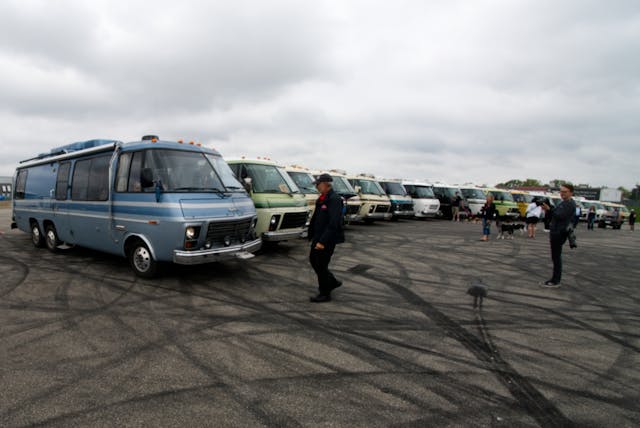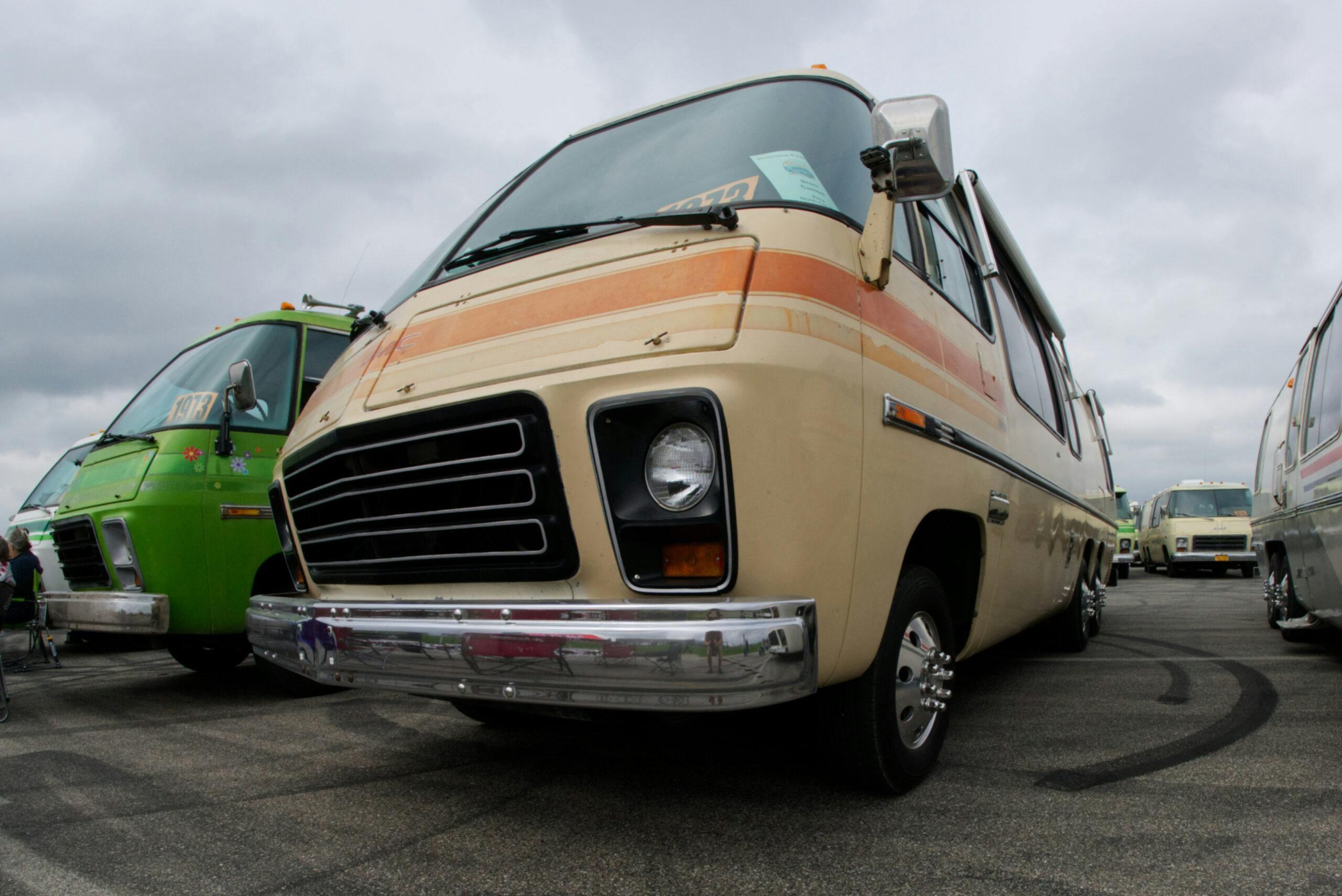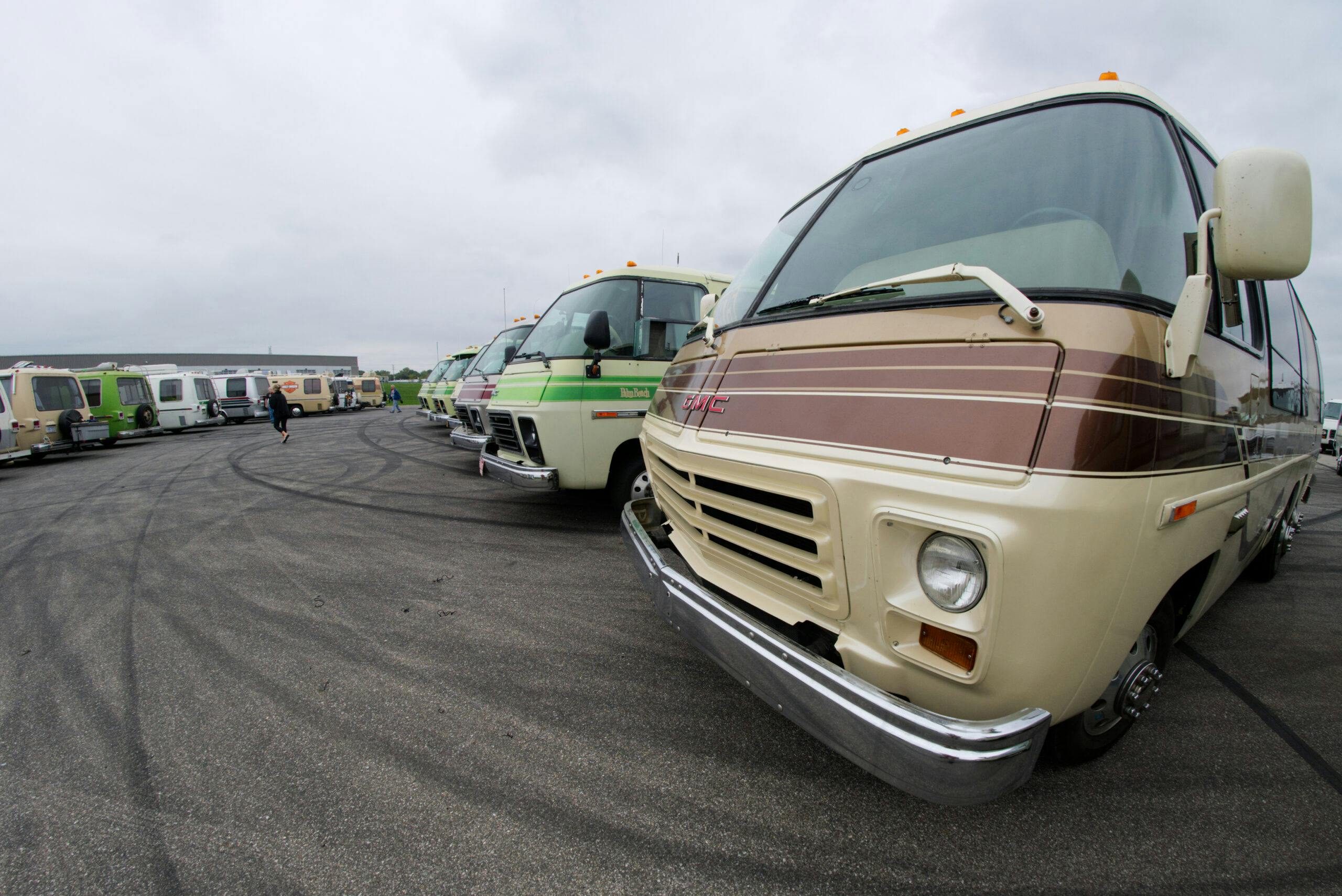A GMC motor-homecoming, 50 years on
From gatherings of historic race cars to the Hemi-centric Roadkill Nights, the track at M1 Concourse in Pontiac, Michigan hosts a wide variety of automotive events. A recent one, held on a cloudy October day, was a bit out of the ordinary. Roughly eighty 1973–1978 GMC Motorhomes arranged themselves in formation on the facility’s skidpad.
They weren’t lost. In fact, they were home; each and every one of these GMCs rolled off an assembly line in that very spot roughly fifty years ago.
Long before M1 Concourse broke ground on its motorsports-centric playground in 2014, the plot of land at the corner of Woodward Avenue and South Boulevard played a key role in General Motors’ truck history. Rapid Trucks built a factory here in 1906, three years before GM bought the company, merged it with another manufacturer (Reliance), and rebranded the married pair under a less-than-creative nameplate: GMC.
After an even bigger manufacturing complex opened just down the road in 1928, the original Rapid plant—now known as old Plant 1—focused on machining and component manufacturing. GMC expanded its footprint in subsequent years, buying neighboring buildings and incorporating them as Plants 3, 4, and 5. While GMC would occasionally build some vehicles on these grounds (namely the original G10 Handi-Van that followed the Corvair 95), there was a much more interesting project waiting in the wings.
The mid-‘60s was a time of sweeping change for the Coach wing of GMC Truck & Coach. After losing a near-exclusive supply deal with Greyhound and being forced by the U.S. Justice Department to provide its unique two-stroke diesels and angle-drive transmissions to rival brands, designers, engineers, and management alike scrambled to brainstorm new ways the division might regain a competitive edge. Jet-age ideas, like luxurious gas turbine low-floor buses with Eames-esque bucket seats, or multi-modal buses that could connect to a Sikorsky Skycrane helicopter, were all apparently on the table, even if only briefly, at one point or another.
One of the more grounded proposals: a “mini bus,” for ferrying suburbanites in less densely-populated areas to larger buses running on higher-frequency routes. The mini bus vehicle concept quickly morphed into a call for a space-efficient multi-purpose commercial vehicle platform. Then, given the booming recreational vehicle market at the time, the decision was made to launch it first as a motorhome.
The resulting GMC Motorhome, which debuted in late 1972 for the 1973 model year, was unlike any other RV on the market, or any other GMC product at the time. A reason for that, perhaps, is the result of its being developed with an independent spirit that was fairly rare within GM.

“Traditionally, our advanced design group would think up features that could or should be in a vehicle, and turn it over to the production group to make it reality once we were done,” recalled former Truck & Coach engineer Claude White. “That changed with Motorhome—instead, we were told we would shepherd it all the way to production. And since it wasn’t a high-volume, high-budget project, we had the flexibility and freedom to design this exactly the way we thought a motorhome should be.”
The finished product lived up to the words on the original sales brochure’s cover: “It doesn’t look like a box or ride like a truck.”

The Motorhome’s exterior design stood in stark contrast to the lanky, upright corrugated boxes-on-wheels cranked out by Winnebago and its ilk at the time. GM’s truck studio penned a sleek, smooth-sided vehicle with a tapered nose, wrap-around windshield glass, and plenty of tumble home, lending it a shoulder that carried through all 23- or 26 feet of the vehicle, depending on which length you ordered.
Things were equally interesting underneath the molded-composite skin. The Motorhome’s low profile came courtesy of a unique, low-slung chassis, which was made possible by adopting the 455-cu-in V-8 and front-wheel drive transaxle (collectively dubbed the Unitized Power Package) from the Oldsmobile Toronado. Conventional “dualie” rear wheels were eschewed for an air-sprung tandem bogie arrangement, maximizing available interior space while improving ride quality and allowing for the coach to be self-leveled at campsites.

With these innovations and GM’s industry clout, it seemed a safe bet that GMC was about to turn the RV industry on its ear once production kicked off in good old Plant 3 in Pontiac. Time, in the end, was not on the Motorhome’s side. Shortly after GMC filled order books for the entire first year of production, the oil embargo struck, kneecapping the RV industry as a whole. Worse, GM’s interior supplier struggled to keep up with production, leading to a backlog of orders.

By 1975, GM had brought interior upfitting in-house, improving volumes. Meanwhile, the introduction of the Transmode—a blank shell for bodybuilders to convert into ambulances, shuttle buses, and covert urban assault vehicles—allowed the Motorhome to reach new customer bases. Still, it didn’t take long for another major stumbling block to arise.
Oldsmobile had already discontinued its 455 engine in late 1977, forcing GMC to move to the smaller 403 in 1978. Then, plans for vastly downsized 1979 Toronado rendered the Unitized Power Package—the heart of GMC’s chassis design—obsolete. GMC toyed with ideas to find an alternate powerplant or redesign the Motorhome entirely, but it ultimately decided such development costs outweighed the potential return. Production ceased in late 1978, and the plants previously used to build GM’s RV-of-the-future were retooled to crank out more Rally and Vandura full-size G-vans. All told, just shy of 13,000 Motorhomes were built in Pontiac, and roughly 9000 examples are accounted for today.
So why has the GMC Motorhome endured, despite its brief and checkered chapter in the annals of RV history? Many owners present at M1 echoed the very same selling points GMC touted five decades prior:
“It’s the perfect size.”
“It drives so well.”
“It rides like no other motorhome.”

For Marv Miller of Indiana, who’s owned his 1977 example for 15 years and helped encourage several other RVers to join the GMC fold, the attraction is simple: “I was working in the RV industry when these were new. There was almost nothing else like them then, and that’s still the case now.”
If nothing else, it’s impressive to see just how well these homes-away-from-homes have aged. While some original details (namely those original paisley interior fabrics and deep-pile carpets) feel dated, the Motorhome’s overarching design does not come off as something created over a half-century ago.

Without a doubt, the Motorhome’s posthumous success is equally due to a tight-knit and supportive owner’s community. Not only have groups like GMC Motorhomes International compiled a rich trove of historical materials and technical information, but members are enthusiastic about helping keep other coaches out on the road. Whether a GMC is treasured in original form, highly restomodded, or is kept running as a scraggly, well-worn machine, there’s no gatekeeping to be found in this club. Every fellow GMCer gets a hearty welcome.

Will the GMC Motorhome’s legacy continue for another fifty years, despite their age and ever-increasing scarcity of specialized parts? That’s hard to say. But where we stand already far surpasses what GMC engineer Karl Gross could have imagined when helping create this vehicle in the first place.
“Someone asked me, ‘what did you think when you designed this motorhome; did you think they’d be around in 50 years?’” Gross told the owners assembled at M1. “I was fresh out of engineering college, on my first job assignment; I never once thought about that, but it’s such a pleasure to see all these still on the road a half-century later.”
***
Check out the Hagerty Media homepage so you don’t miss a single story, or better yet, bookmark it. To get our best stories delivered right to your inbox, subscribe to our newsletters.



















Driving truck back in those days.
I always the GMs were the best looking out there.
Some other brands hurt your eyes, they were so ugly.
I can tell you where to find parts, a couple for sale, and a dozen of these waiting for light to moderate restoration: of all places little uberconservative white trash cowtown Okeechobee, FL! https://sirumvintagegmc.com
A key reason they survive: they were not made of particle board skinned with aluminum and sealed with sheet metal screws. That temporary design turns most RVs into difficult to dispose of scrap once they hit some weather and some bumps…I would’ve liked to see some interior pictures.
When I was a kid growing up in the country, every other week in the summer the “bookmobile” would pull up near our house. It was a converted GMC motor home. Very cool library on wheels. I remember this to be 1984 as I still have a book I checked out from that GMC. The book? Stephen King’s ‘Christine’ of course!
I was working at GMC Truck and Coach where these were made in 1974
Then came the oil embargo, a major order of AstroVans was cancelled and GM offered them to employees at cost and would even take 0% loans on them and have it deducted from your paycheck
If I had only known
We had a 26’ orange GMC we called Rosante. We got it for our honeymoon trip in June 1973. My father kept track of it build in Pontiac. We traveled the west coast of US from Detroit north to Puget Sound down highway 5 into CA And across Mohave into AZ, Grand Canyon, TX, LA AND back north home. A two month long trip. Not many dealerships had even seen one.